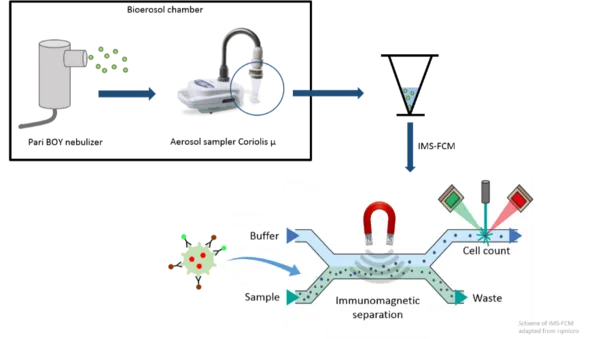Release mechanisms of aerosols containing Legionella in evaporation cooling systems and significant analytical methods for outbreak management
OBJECTIVE
In the past, there was a focus on measurements of Legionella in the water of cooling systems but not of them in aerosols, although the release of aerosols containing Legionella has led to several outbreaks of lung diseases. Therefore, it is important to establish methods for sampling and analyzation of Legionella in aerosols.
Culture-based methods are still the gold standard for the detection of Legionella although they contain some disadvantages like a long analysis time (7-10 days). Another problem is that the Legionella can go to a viable but non-culturable state (VBNC), so they can’t be detected with cultural methods. To prevent this, it is necessary to find culture-independent options for the analysis.
The main objects are:
- Comparison of different aerosol collecting devices (Impinger, Impactor, Cyclone sampler) to get information
about biological sampling efficiency
- Establishment of culture-independent analytical methods
• Chemiluminescence sandwich-microarray-immunoassay (CL-SMIA)
• heterogeneous asymmetric recombinase polymerase amplification (haRPA)
• Immunomagnetic separation coupled with flow cytometry (IMS-FCM)
• Quantitative polymerase chain reaction (qPCR)
- Using a laboratory cooling system to generate aerosols with living Legionella and to get knowledge about
release behavior of aerosols
- Field tests with real evaporation cooling systems
METHODS
1) Chemiluminescence sandwich-microarray-immunoassay (CL-SMIA):
This antibody dependent screening method allows the characterization of different serogroups (Sg) and
subgroups simultaneously. Therefore, an analysis on the Microarray-Chip-Reader-Research (MCR-R) with
a CCD-camera is performed.
2) Heterogeneous asymmetric recombinase polymerase amplification (haRPA):
This analytical method is based on a DNA microarray. With the addition of a DNA-intercalating dye, a
distinction between living and dead cells can be achieved.
3) Quantitative Polymerase Chain Reaction (qPCR)
After a DNA extraction, the DNA is analyzed through PCR, whereas an amplification takes place. Through
the addition of a special dye during the extraction, a distribution between intact and damaged cells is
possible.
4) Immunomagnetic separation coupled with flow cytometry (IMS-FCM)
With this antibody-based method, magnetic particles and a staining dye, both coupled to antibodies, allow
the detection of Legionella pneumophila Sg 1. A distribution between intact and damaged cells is also
possible through the addition of propidium iodide.

INVOLVED PHD STUDENTS
M.Sc. Lena Heining
PARTNERS
Institut für Energie- und Umwelttechnik (IUTA) in Duisburg
FINANCIAL SUPPORT
AiF